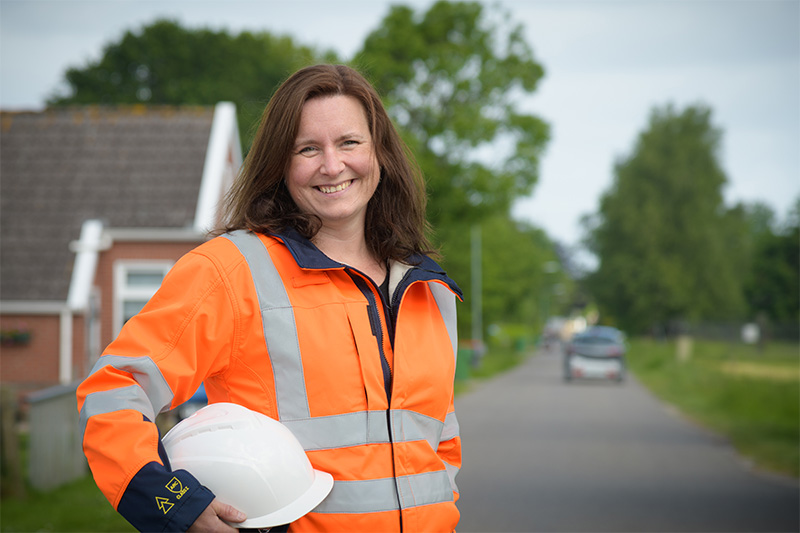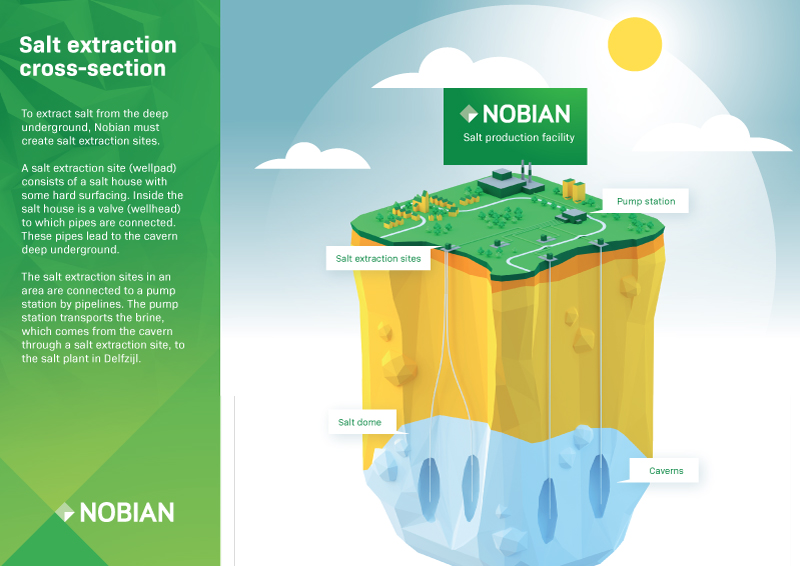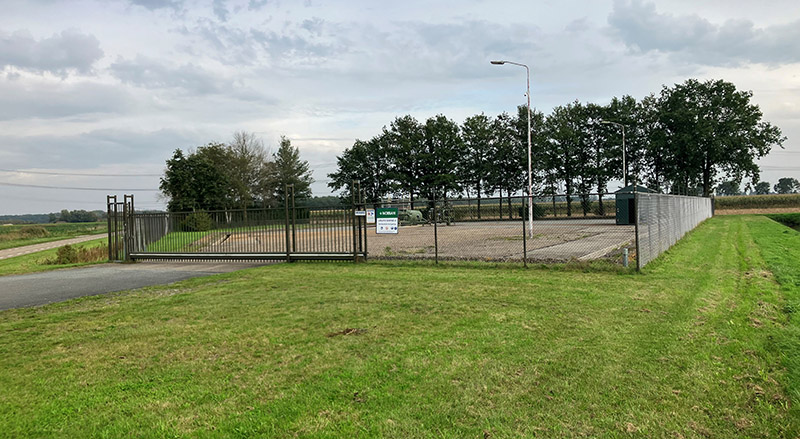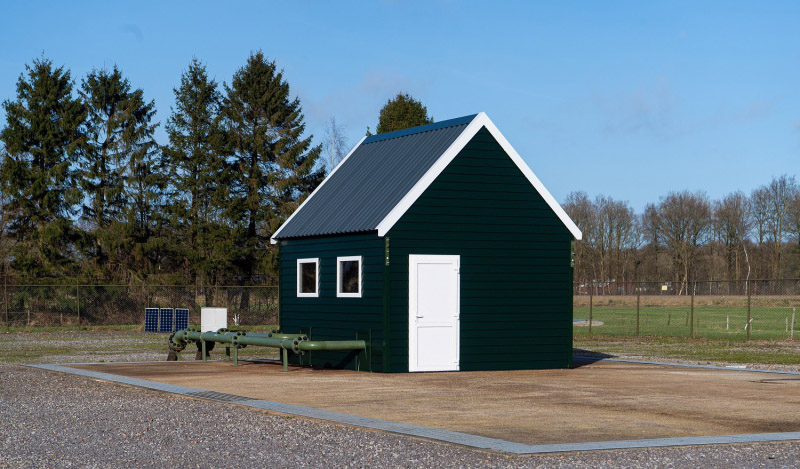“I am convinced that the quality of our designs has improved significantly because of the input of the local residents.”
Before I interviewed Ellen de Waard, Community Engagement Manager at Nobian, I did not know how salt is produced or that salt is part of many everyday products. Moreover, Nobian’s salt mining work contributes to the production of green energy.
At Nobian, chemistry and sustainability are merged.Nobian extracts salt from the ground in the North and East of The Netherlands. Ellen has the difficult task to explain to the local residents in the North of the country, who are historically cautious of the mining industry, that salt mining is safe, useful, and necessary. And even though Ellen admits that she will never truly convince them, she always asks for input on the design and placement of new mining sites. Ellen is convinced that clear and transparent communication can alleviate some of their concerns.
Ellen introduced me to the wonderful world of salt mining and gas storage. She explained to me how she uses SitePodium to communicate with a reluctant stakeholder group. This is part 1 of her 2-part story.

Salt mining in The Netherlands
“Oil is not the only resource for the production of plastic, salt is as well”, Ellen explains. “Salt is everywhere, from the picture behind you to the paint on your shed.” She has a background in construction and when she started working as Community Engagement Manager for Nobian, she did not know what to expect. What she did know from her civil background, is that SitePodium would be a useful tool in this sector as well. This led her to introduce our app to the chemical industry, salt mining, and Nobian in particular.
Now she is able to explain everything to me in detail, partly because she also regularly does so to local residents. There is a petrified salt layer under the ground; as hard as concrete. By drilling a hole in this sodium salt and filling it with water, the salt is dissolved and pumped out of the ground, where it is later extracted again at their factory. The cavern that is formed as a result of this, is safely closed off once it has reached its maximum size and mining has come to an end.

A historically fearful stakeholder group
Mining in the North of The Netherlands has a negative reputation. This is the direct result of the extensive gas mining that was carried out there and which has caused minor earthquakes in the past. It is Ellen’s task to convince the residents that salt mining is safe. But because of these negative experiences, this is an already fearful group of stakeholders who, according to Ellen, will never fully be on her side.
“This is something that Nobian is very aware of”, says Ellen. “We will never overcome the ‘not in my backyard’ sentiment. What we can do is convince residents of their safety, the benefits of our work, and we can let them contribute their ideas. We can be approachable and communicate transparently.” This has to be done within a strict framework set by Nobian. “The intended goal, the development of salt caverns, remains”, Ellen explains.
How does Ellen make sure that she gains the support of this reluctant audience? She does this by involving residents wherever she can. She often visits people at home, organises meetings for residents, asks for their input on the designs, and uses SitePodium to communicate fast and transparently: “The app allows us to be accessible and approachable.”

Types of nuisance
A Nobian salt mining site is not as noticeable in the landscape as a power station outside of town or a gas pump. But the North of Groningen is an open area with very little forest. The placement of a new site can cause noise, block views, and change the look of the landscape forever.
Current locations need to be maintained every 3 to 5 years. During these 3 to 4 weeks of maintenance work, there will be noise and truck movement. To create a new location, they have to drill 24/7 for 5 to 7 weeks in a row, and that is accompanied by noise, light, and traffic. “The open landscape does not block this, so we take measures to prevent and shield nuisance”, Ellen explains. The major challenge for Ellen, however, is not the sentiment around the disturbance that they cause, but the fact that the residents still feel unsafe when any type of mining takes place in their area.
Participation down to the smallest detail
Because Ellen is dealing with a complex group of stakeholders, she uses a specific approach. She gives the residents a say in where the new locations will be placed, for example. They can drill at an angle or straight down, so there is some flexibility there. Although there is a set framework, the word of Nobian is not always leading. Residents have suggested using the shed behind an empty farm so that the landscape remains unchanged, for example. This is something that Nobian listens to, and negotiations for purchasing the farm for this exact purpose are currently in progress.
Another resident had the idea to reuse an old yard and to place a mining site there. They are allowed to choose between concrete tiles or grass tiles, about what the site cabin will look like, and even about the final colour of the pipes that are above ground. “We are speaking about detailed choices here”, she explains, “and who knows the area better than the residents themselves?” SitePodium is a good medium to visualise this with, and to quickly ask for input.
The result is a design that is better than what Nobian could have come up with themselves. “They still do not want us in their backyard”, explains Ellen, “but our designs have significantly improved, simply because we asked them to participate.”

The future according to Ellen
Stakeholder engagement has become part of Nobian’s future. In terms of participation, Ellen faces a challenge. “In the past, people were more willing and to get them involved will become increasingly difficult. You can feel it when you ask for volunteers at your sports club and everybody turns a blind eye.” According to Ellen, SitePodium can play an important role in combating this phenomenon, which she calls ‘participation fatigue’.
“SitePodium is a general method to use during construction projects in people’s immediate surroundings, but it can also be used for other projects.” Ellen is an excellent example of this herself, as she introduced SitePodium to the chemical sector. “The app includes residents in what is happening in their area”, she explains, “and it does this in a simple and accessible way.”
After our conversation, I have certainly become a lot wiser. The work that Ellen does with residents, and the way in which she uses SitePodium to do so, is nothing short of admirable.
Read more about salt mining and the energy transition in part 2 of our user cases with Ellen de Waard.
